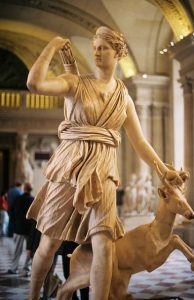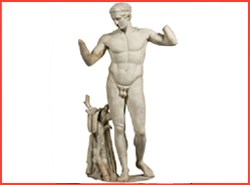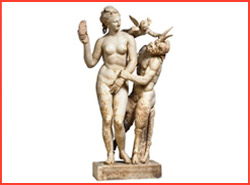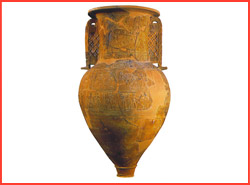Artemis, daughter of Zeus and Leto, and twin sister of Apollo, was goddess of chastity, hunting, wild animals, forests, childbirth, and fertility. Convincing her father to grant her wishes, Artemis desired to remain forever chaste and unmarried and always to be equipped for hunting. The goddess was also associated with the moon and was the patron of young women, particularly brides-to-be, who dedicated their toys to her as symbolic of the transition to full adulthood and the assumption of a wife’s responsibilities.
As a deity of fertility, the goddess was particularly revered at Ephesos, where the famous temple of Artemis (c. 550 BCE) was regarded as one of the Seven Wonders of the World. Other notable places of worship were the sanctuaries at Brauron, Tauris, and on the island of Delos, where the goddess was born and where she assisted the birth of her brother Apollo, as Greek mythology tells us.
THE HUNTER AKTAION WAS TURNED INTO A STAG BY THE GODDESS AFTER HE DARED BOAST HE WAS THE GREATER HUNTER.
 A notable episode involving the goddess is the saving of Iphigeneia, daughter of Agamemnon. The king had displeased the goddess by killing one of her sacred deer. As punishment, Artemis becalmed the Archaean fleet and only the sacrifice of Iphigeneia would appease the goddess into granting a fair wind to Troy. Agamemnon duly offered his daughter in sacrifice but in pity and at the last moment, the goddess substituted a deer for the girl and made Iphigeneia a priestess at her sanctuary at Tauris.
A notable episode involving the goddess is the saving of Iphigeneia, daughter of Agamemnon. The king had displeased the goddess by killing one of her sacred deer. As punishment, Artemis becalmed the Archaean fleet and only the sacrifice of Iphigeneia would appease the goddess into granting a fair wind to Troy. Agamemnon duly offered his daughter in sacrifice but in pity and at the last moment, the goddess substituted a deer for the girl and made Iphigeneia a priestess at her sanctuary at Tauris.
Other accounts of Artemis, however, display her in a far less charitable light. She is said to have killed the hunter Orion after his attempted rape of either Artemis herself or a follower. Callisto was turned into a bear after she had lain with Zeus, who then turned her and her son Arcas into the constellations the great and little bear. The goddess uses her bow to mercilessly kill the six (or in some accounts seven) daughters of Niobe following her boast that her childbearing capacity was greater than Leto’s. The hunter Aktaion was turned into a stag by the goddess after he dared boast he was the greater hunter. Actaion was then torn to pieces by his pack of 50 hunting dogs. Finally, Artemis sent a huge boar to ravage Kalydon after the city had neglected to sacrifice to the goddess. An all-star hunting party of heroes which included Theseus, Jason, the Dioskouroi, Atalanta, and Meleager was organised to hunt and sacrifice the boar in Artemis’ honour. After a lengthy expedition, Atalanta and Meleager do finally succeed in killing the boar.
Artemis / Diana
Artemis, playing only a minor role in Homer’s Iliad, is described most often as ‘the archer goddess’ but also on occasion as the ‘goddess of the loud hunt’ and ‘of the wild, mistress of wild creatures’. Supporting the Trojans, she notably heals Aeneas after he is wounded by Diomedes. Hesiod in his Theogony most often describes her as ‘arrow-shooting Artemis’.
Artemis is most frequently portrayed in ancient Greek art as a maiden huntress with quiver and bow, often accompanied by a deer and on occasion wearing a feline skin. Early representations also emphasise her role as goddess of animals and show her winged with a bird or animal in each hand. For example, on the handles of the celebrated Francois vase, she holds a panther and stag in one depiction and lions in another. In later Attic red- and black-figure vases she is also often depicted holding a torch. A celebrated marble representation of the goddess is on the east frieze of the Parthenon where she is seated with Aphrodite and Eros (c. 440 BCE).






